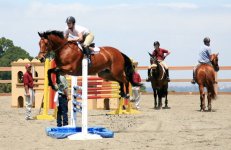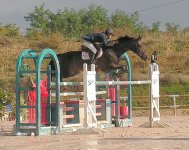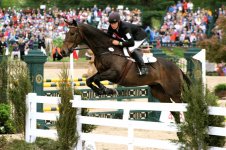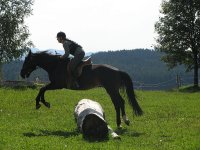Releases
In all cases, the rider should release the horse over a fence, or in other words, lengthen enough rein so the horse can stretch its neck forward and use it as a balancing mechanism. The key to a good release is relaxed arms with proper hand, wrist, and elbow position. First, the arms (elbows and shoulders) should be soft and elastic, allowing the horse to pull them forward as needed. Preferably, there should be a straight line from bit to elbow (automatic release), as this improves contact and communication between horse and rider. The wrists of the rider should remain soft and straight, as bent wrists tend to stiffen the lower arm. The elbows should be next to the rider's side, not "chicken-winged" and pointing outward, which decreases flexibility and softness.
As in all riding, the hands should be softly closed, neither tightly holding the reins which causes tension and stiffness, or so soft that the reins easily slip through. The one exception to this rule is when the rider needs to slip the reins.
[edit] Types of releases
Difference releases are used depending on circumstances. However, all riders should strive to readily be able to use each one as needed, and should practice them all.
Basic release: the rider grabs the mane of the horse. This allows the rider to avoid falling back and hitting the horse in the mouth or back, or try to use the mouth for balance. It is used by beginning riders who do not yet have the position and balance to do more advanced releases without risking hitting their horse in the mouth. It is also used by more advanced riders on green horses, who tend to overjump, or when a rider for some reason loses position due to an awkward jump. Riders should not think it is reserved for novices, and all good riders will grab mane to save their horse's mouth. However, it provides the least amount of control. It should therefore not be used if it is not required.
Short crest release: the rider slides the hands up the crest as the horse takes off, not before (which "drops" the horse). The hands should not slide far up the crest, only a couple inches, as needed. It provides support for the rider's upper body, while still providing a good amount of control because the rider did not release any more than needed. Best used on verticals, when the rider needs to turn mid-air, or when going down drop fences. An intermediate release.
Long crest release: Similar to the short crest release, in that the rider slides his hands up the crest, but the hands are pushed much further along the neck. Gives a great deal of freedom, but fairly little control. Best for very wide oxers, to allow the horse to really stretch across, or for green horses that may jump large or awkwardly, for gymnastics grids, and for use on horses that have been hit in the mouth over fences and are reluctant to jump or stretch down over a fence. The rider should be careful not to associate a large movement forward with the hands and elbows to mean a movement forward with the hips. The hip angle should still close backward. Many riders get into the habit of jumping ahead with this release. Critics say this release is overused and exaggerated by hunter riders; in the hunter ring it is often used by experienced and/or professional riders on well-trained horses over jumps of relatively modest size. Proponents say that this shows off a talented hunter by proving the horse needs little assistance from the rider to jump in good form.
Automatic release: The most advanced release, where the rider maintains a soft, elastic, steady rein contact with a straight line from elbow to bit as the horse jumps. This release results in a great deal of control and communication between horse and rider, allowing the rider to signal to the horse what to do on landing. It allows the rider to better turn while in the air, to correct horses that jump crookedly, and to provide the support that some horses prefer over fences. It is also good on horses that need lots of control after landing. However, the automatic release requires perfect balance from the rider to be executed correctly. An unsteady rider will catch the horse in the mouth, and an incorrect automatic release will spoil a horse's jump and confidence. However, if a rider is able to perform it correctly, it is often best to use this release whenever possible. Very useful in show jumping and eventing, where control is very important.
Slipping the reins: Not a release, per se, simply letting the reins slide through the hands a bit. It is a very valuable tool all riders should have. To be used when the rider gets behind the motion by accident, when riding drop fences or fences with a downhill landing, or when a horse gets in trouble over a fence (such as catches a leg on a cross-country fence). Allows the rider to release the horse and give him the freedom he needs, without forcing the rider to do one of the other releases (which are inappropriate for drop fences). However, it results in extra long reins on landing, so the rider must be able to immediately gather up the reins and shorten them to the correct length.
With experience, riders learn by feel to instinctively choose the correct release.
Common Faults
Not releasing: This is a cardinal sin in all riding circles, as it causes the horse to jump flat and, more importantly, can result in the horse to detest jumping because it is associated with pain, which will eventually lead to stopping. A poor release may occur for several reasons. First, the rider may use the reins for support over the fence because he or she has not developed correct balance. This rider should be sure to grab mane to avoid hitting the horse in the mouth. Secondly, a rider may be left behind the motion for various reasons. In these cases, the rider should be sure to slip the reins. Some riders ride this way when they are mounted on strong horses, and they wish to tell the horse to slow down over the fence before landing, or get in the habit of overusing their hands between fences and forget to release. In this case, the rider must make a conscious effort to remember to release the horse in the air. It also occurs when riders plant their hands on the neck over a fence to support their upper body, but the hands are placed too far back to allow adequate rein for the horse, or if the riders keep contact during takeoff but stiffen their elbows so that they don't follow that contact forward over the fence. Occasionally, it appears as if a rider is not releasing enough, when in fact he or she is slipping the reins or performing a correct automatic release.
Incorrect release: When the rider releases by shoving his hands above the horse's neck, into the air, or way down below the neck. This not only looks sloppy, but changes the rider's balance over fences.
Retrieved from "http://en.wikipedia.org/wiki/Jumping_position"
عکس اول :
Short crest release
عکس دوم :
A long crest release being used for a large oxer to allow the horse more freedom.
عکس سوم:
The automatic release: the rider has a straight line from elbow to bit, and maintains a soft, elastic contact with the horse's mouth
عکس چهارم:
Slipping the reins while going down a drop.
عکس پنجم :
This rider has hit his horse in the mouth because he is not releasing sufficiently.
منبع:
Jumping position - Wikipedia, the free encyclopedia




